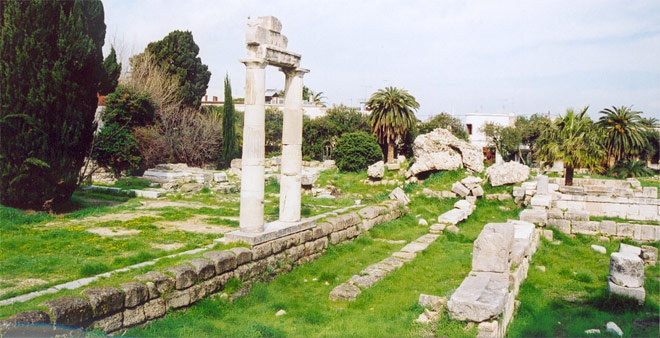
In antiquity, the agora (forum) of every city was its commercial and social centre. The ancient Agora of Kos is among the largest to have been excavated in Greece to this date. Originally it was built during the 4th century B.C. near the city's port.
After 366 B.C. when the city of Kos was recognized as an important administrative center, important public and religious buildings were constructed in the area of the port and of the Agora. The latter was the financial heart of the island, with streets, workshops, shops and altars that consitute the "traditional" image of an ancient agora.
The archaeological site was excavated by the Italian Archaeological School, during the reconstruction of the city, after the destructive earthquake of 1933. The Agora had trhee main gates (eastern, western, northern). The roads from the three gates convergedin the center in a large internal courtyard. The northern gate connected the Agora with the city walls, while the other two hosted a number of shops tending to the citizens' everyday needs.
The frequent earthquakes hitting the island were a reason for repeated reconstructions of the city. Different materials used by the locals help distinguis the diferent construction phases.
The earthquake of the 6th or 5th century B.C. left no traces to the construction history of the city. From 366 B.C. and all through the third century, buildigns are created with "amygdalopetra", a type of limestone and greenish poros stone. Marble is rare.
During the next period, marble is used widely. During the 2nd century B.C. the monumental buildings are constructing, giving a magnificent view to the city.
The reconstruction that followed the earthquake of 142 A.D. changed the image of the city once again. New construction methods are used ("cast wall making") and new buildings and complexes are constructed, such as the Thermes, the theater and the stadium. The agora and the neighboring building blocks are reconstructed.
The earthquake of 469 A.D. brought a critical change that marked the end of the ancient city and the beginning of the early christian era.
Today, the ruins of the Agora are part of the broader archaeological zone of the port, which covers an area of 152 meters long by 82 meters wide. The visitor can see among others the Agora, part of the fortication of the city, the sanctuaries of Aphrodite and Hercules, building blocks with some remains of private houses but also a part of the ancient port of the city. However the biggest part of the Agora lies burried under the modern city. The southern part of the Agora was only recently excavated - opposite the altar of Dionysus.
Text Source: www.kos.gr




